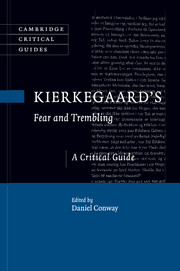Book contents
- Frontmatter
- Contents
- List of Contributors
- Acknowledgments
- List of Abbreviations
- Introduction
- Chapter 1 Homing in on Fear and Trembling
- Chapter 2 Fear and Trembling’s “Attunement” as midrash
- Chapter 3 Johannes de silentio’s dilemma
- Chapter 4 Can an admirer of silentio’s Abraham consistently believe that child sacrifice is forbidden?
- Chapter 5 Eschatological faith and repetition: Kierkegaard’s Abraham and Job
- Chapter 6 The existential dimension of faith
- Chapter 7 Learning to hope: the role of hope in Fear and Trembling
- Chapter 8 On being moved and hearing voices: passion and religious experience in Fear and Trembling
- Chapter 9 Birth, love, and hybridity: Fear and Trembling and the Symposium
- Chapter 10 Narrative unity and the moment of crisis in Fear and Trembling
- Chapter 11 Particularity and ethical attunement: situating Problema III
- Chapter 12 ‘He speaks in tongues’: hearing the truth of Abraham’s words of faith
- Chapter 13 Why Moriah?: weaning and the trauma of transcendence in Kierkegaard’s Fear and Trembling
- Bibliography
- Index
- References
Chapter 1 - Homing in on Fear and Trembling
Published online by Cambridge University Press: 05 February 2015
- Frontmatter
- Contents
- List of Contributors
- Acknowledgments
- List of Abbreviations
- Introduction
- Chapter 1 Homing in on Fear and Trembling
- Chapter 2 Fear and Trembling’s “Attunement” as midrash
- Chapter 3 Johannes de silentio’s dilemma
- Chapter 4 Can an admirer of silentio’s Abraham consistently believe that child sacrifice is forbidden?
- Chapter 5 Eschatological faith and repetition: Kierkegaard’s Abraham and Job
- Chapter 6 The existential dimension of faith
- Chapter 7 Learning to hope: the role of hope in Fear and Trembling
- Chapter 8 On being moved and hearing voices: passion and religious experience in Fear and Trembling
- Chapter 9 Birth, love, and hybridity: Fear and Trembling and the Symposium
- Chapter 10 Narrative unity and the moment of crisis in Fear and Trembling
- Chapter 11 Particularity and ethical attunement: situating Problema III
- Chapter 12 ‘He speaks in tongues’: hearing the truth of Abraham’s words of faith
- Chapter 13 Why Moriah?: weaning and the trauma of transcendence in Kierkegaard’s Fear and Trembling
- Bibliography
- Index
- References
Summary
Introduction
Questions posed by the stark cameo of parental sacrifice in Fear and Trembling penetrate to the heart of Kierkegaard’s writings. Yet to serve as an introduction to these, the work itself must be read through a suitably adjusted lens. To those meeting Kierkegaard here for the first time, Abraham’s willingness to sacrifice Isaac and the attached notion of “suspending the ethical” may simply confirm those once widespread rumors of the Danish writer’s irrationalism. Even sympathetic commentators seeking a place for it within a consistent picture of Kierkegaard’s thought and works can feel its challenge.
A useful first adjustment is to read Fear and Trembling in the context of Kierkegaard’s lifelong project of relieving the traditional disciplines of philosophy and theology of their hold on questions of value and morals. If only as a start, it helps to see Fear and Trembling as a literary stunt aimed at startling its readers into considering a situation where, in the absence of such traditional backing, we, the readers, are left to answer such questions on our own.
- Type
- Chapter
- Information
- Kierkegaard's Fear and TremblingA Critical Guide, pp. 6 - 25Publisher: Cambridge University PressPrint publication year: 2015



